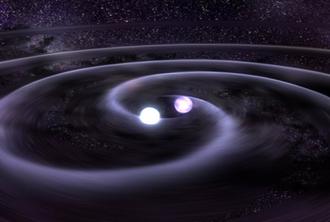« Reading List: Days of Rage | Main | Reading List: Iron Sunrise »
Tuesday, December 25, 2018
Gnome-o-gram: Whence Gold?
 By the time I was in
high school in the 1960s, the origin of the chemical elements seemed
pretty clear. Hydrogen was created in the Big Bang, and very shortly
afterward about one quarter of it fused to make helium with a little
bit of lithium. (This process is now called Big Bang
nucleosynthesis, and models of it agree very well with astronomical
observations of primordial gases in the universe.)
By the time I was in
high school in the 1960s, the origin of the chemical elements seemed
pretty clear. Hydrogen was created in the Big Bang, and very shortly
afterward about one quarter of it fused to make helium with a little
bit of lithium. (This process is now called Big Bang
nucleosynthesis, and models of it agree very well with astronomical
observations of primordial gases in the universe.)
All of the heavier elements, including the carbon, oxygen, and nitrogen which, along with hydrogen, make up our bodies and all other living things on Earth, were made in stars which fused hydrogen into these heavier elements. Eventually, the massive stars fused lighter elements into iron, which cannot be fused further, and collapsed, resulting in a supernova explosion which spewed these heavy elements into space, where they were incorporated into later generations of stars such as the Sun and eventually found their way into planets and you and me. We are stardust. But we are made of these lighter elements—we are not golden.
But, as more detailed investigations into the life and death of stars proceeded, something didn't add up. Yes, you can make all of the elements up to iron in massive stars, and the abundances found in the universe agree pretty well with the models of the life and death of these stars, but the heavier elements such as gold, lead, and uranium just didn't compute: they have a large fraction of neutrons in their nuclei (if they didn't, they'd be radioactive [or more radioactive than they already are] and would have decayed long before we came on the scene to observe them), and the process of a supernova explosion doesn't seem to have any way to create nuclei with so many neutrons. "Then, a miracle happens" worked in the early days of astrophysics, but once people began to really crunch the numbers, it didn't cut it any more.
Where could all of those neutrons could have come from, and what
could have provided the energy to create these heavy and relatively
rare nuclei? Well, if you're looking for lots of neutrons all in the
same place at the same time, there's no better place than a neutron star,
which is a tiny object (radius around 10 km) with a mass greater than
that of the Sun, which is entirely made of them. And if it's energy
you're needing, well how about smashing two of them together at a
velocity comparable to the speed of light? (Or, more precisely, the
endpoint of the in-spiral of two neutron stars in a close orbit as
their orbital energy decays due to emission of gravitational
radiation.) Something like this, say.
This was all theory until 12:41 UTC on 2017-08-17, when gravitational wave detectors triggered on an event which turned out to be, after detailed analysis, the strongest gravitational wave ever detected. Because it was simultaneously observed by detectors in the U.S. in Washington state and Louisiana and in Italy, it was possible to localise the region in the sky from which it originated. At almost the same time, NASA and European Space Agency satellites in orbit detected a weak gamma ray burst. Before the day was out, ground-based astronomers found an anomalous source in the relatively nearby (130 million light years away) galaxy NGC 4993, which was subsequently confirmed by instruments on the ground and in space across a wide swath of the electromagnetic spectrum. This was an historic milestone in multi-messenger astronomy: for the first time an event had been observed both by gravitational and electromagnetic radiation: two entirely different channels by which we perceive the universe.
These observations allowed determining the details of the material ejected from the collision. Most of the mass of the two neutron stars went to form a black hole, but a fraction was ejected in a neutron- and energy-rich soup from which stable heavy elements could form. The observations closely agreed with the calculations of theorists who argued that elements heavier than iron that we observe in the universe are mostly formed in collisions of neutron stars.
Think about it. Do you have bit of gold on your finger, or around your neck, or hanging from your ears? Where did it come from? Well, probably it was dug up from beneath the Earth, but before that? To make it, first two massive stars had to form in the early universe, live their profligate lives, then explode in cataclysmic supernova explosions. Then the remnants of these explosions, neutron stars, had to find themselves in a death spiral as the inexorable dissipation of gravitational radiation locked them into a deadly embrace. Finally, they collided, releasing enough energy to light up the universe and jiggle our gravitational wave detectors 130 million years after the event. And then they spewed whole planetary masses of gold, silver, platinum, lead, uranium, and heaven knows how many other elements the news of which has yet to come to Harvard into the interstellar void.
In another document, I have discussed how relativity explains why gold has that mellow glow. Now we observed where gold ultimately comes from. And once again, you can't explain it without (in this case, general) relativity.
In a way, we've got ourselves back to the garden.
Posted at December 25, 2018 15:54